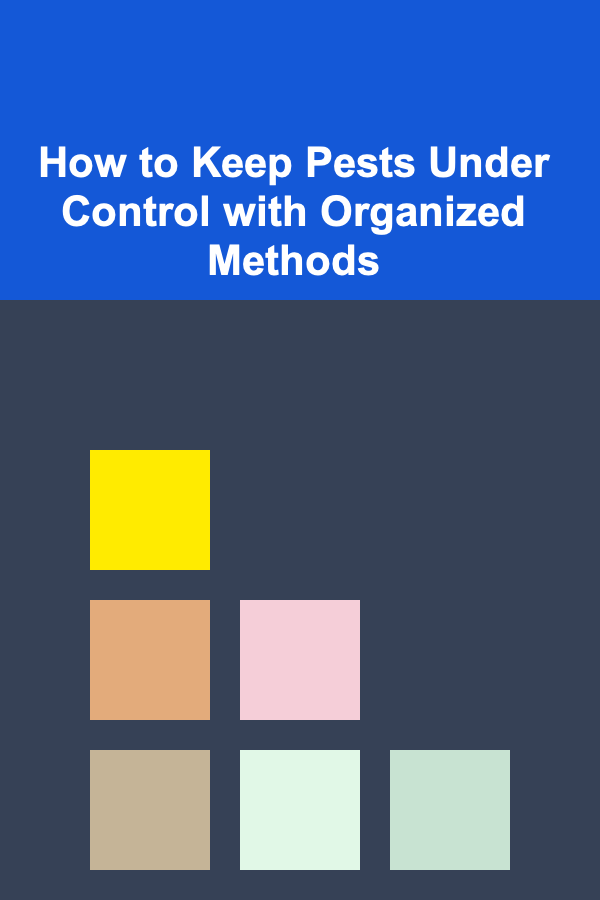
How to Keep Pests Under Control with Organized Methods
ebook include PDF & Audio bundle (Micro Guide)
$12.99$11.99
Limited Time Offer! Order within the next:

Pest management is a crucial aspect of gardening and agriculture that can significantly affect both plant health and crop yield. An organized approach to pest control not only enhances the effectiveness of your strategies but also minimizes environmental impact, reduces costs, and promotes sustainable practices. This comprehensive guide will explore various organized methods for controlling pests in your garden or agricultural setting.
Understanding Pests
1. What Are Pests?
Pests are organisms that cause damage to crops, plants, or livestock. They can include insects, weeds, fungi, bacteria, and even animals. Understanding the types of pests you may encounter is essential for developing effective control methods.
2. Common Types of Pests
- Insects: Aphids, beetles, caterpillars, and mites are some common insect pests that can damage plants.
- Weeds: Unwanted plants that compete for nutrients, light, and water.
- Fungi: Pathogenic fungi can lead to diseases like powdery mildew or root rot.
- Nematodes: Microscopic worms that can infest roots and soil.
3. The Life Cycle of Pests
Understanding the life cycle of specific pests helps in timing your control methods effectively. Most pests go through stages such as egg, larva, pupa, and adult, each requiring different management strategies.
4. Environmental Factors
Pests thrive under specific conditions. Factors such as temperature, humidity, and season can heavily influence pest populations. Keeping these in mind can help you anticipate problems before they arise.
A solid understanding of pests lays the groundwork for organized pest control methods.
The Importance of Organization in Pest Control
1. Enhanced Efficiency
An organized approach allows you to streamline your pest management efforts. Knowing which methods to use, when to apply them, and how to monitor results saves time and resources.
2. Improved Effectiveness
A systematic plan for pest control ensures that you're using the most appropriate methods based on the specific pests present and their life cycles. This maximizes the likelihood of success.
3. Reduced Chemical Usage
By implementing organized methods, you can often reduce reliance on chemical pesticides, which are not only costly but also potentially harmful to beneficial insects and the environment.
4. Increased Awareness
An organized system heightens your awareness of pest issues in your garden or field, allowing for quicker responses and better outcomes.
5. Sustainable Practices
Effective pest control methods prioritize sustainability. By organizing your approach, you can implement integrated pest management techniques that consider ecological relationships.
Recognizing the importance of organization in pest control prepares you to embark on a structured approach.
Types of Pest Management Strategies
1. Prevention
Preventative measures are the first line of defense against pests. This includes proper planting techniques, crop rotation, and maintaining plant health.
2. Monitoring
Regular monitoring enables early detection of pest issues. Use traps, visual inspections, and scouting reports to keep track of pest populations.
3. Control
Control methods may be categorized into cultural, physical, biological, and chemical approaches. Each method plays a role in an organized pest management plan.
4. Documentation
Keeping records of pest occurrences, control methods used, and outcomes helps refine future pest management strategies. This documentation forms the backbone of an organized approach.
Each type of strategy contributes to a holistic approach to pest management.
Integrated Pest Management (IPM)
1. Definition of IPM
Integrated Pest Management (IPM) is a comprehensive approach that combines multiple strategies for effective pest control. It aims to minimize risks to human health, beneficial organisms, and the environment.
2. Components of IPM
- Monitoring: Regular scouting and observation allow for timely interventions.
- Threshold Levels: Determine action thresholds to decide when to take control measures.
- Combination of Methods: Utilize a mix of cultural, biological, and chemical methods to manage pests.
3. Benefits of IPM
- Sustainability: Reduces dependency on chemical controls.
- Cost-Effectiveness: Can save money by avoiding unnecessary pesticide applications.
- Ecosystem Health: Protects beneficial organisms and promotes biodiversity.
Implementing IPM requires careful planning and organization, making it a cornerstone of effective pest control.
Monitoring and Identification
1. Regular Scouting
Establish a routine for inspecting plants for signs of pest activity. Regularly check leaves, stems, and the soil for any unusual signs.
2. Tools for Monitoring
Utilize tools such as:
- Sticky Traps: Useful for capturing flying insects.
- Magnifying Glass: Helps identify small pests.
- Field Journals: Keep notes on observations and pest populations.
3. Identifying Pests
Proper identification is critical for effective control. Use field guides, apps, or consult local extension services for assistance in identifying pests accurately.
4. Record Observations
Document your findings regularly, noting the types of pests observed, their locations, and any patterns in their appearance. This information is invaluable for future reference.
5. Pest Forecasting
Use historical data along with current observations to predict potential pest outbreaks. This proactive approach can inform your management strategies.
Monitoring and identification form the basis for effective pest management decisions.
Cultural Practices to Prevent Pests
1. Crop Rotation
Rotate crops annually to disrupt pest life cycles and prevent buildup in the soil.
2. Plant Selection
Choose resistant varieties of plants to minimize susceptibility to pests. Consult local agricultural extensions or gardening groups for recommendations.
3. Soil Health
Maintain healthy soil through organic matter addition, composting, and appropriate fertilization. Healthy plants are less vulnerable to pest attacks.
4. Timing of Planting
Plant at optimal times to avoid peak pest populations. Early or late planting can sometimes miss the window of high pest activity.
5. Cleanliness
Keep your garden clean by removing debris where pests might hide. Regularly weeding and cleaning up fallen fruits can reduce pest habitats.
Incorporating cultural practices into your pest management strategy enhances the overall resilience of your garden.
Physical Barriers and Traps
1. Row Covers
Use lightweight fabric covers to protect young plants from pests while allowing sunlight and rain to reach them.
2. Netting
Install fine mesh netting around fruit trees or vegetable patches to keep birds and larger pests away.
3. Traps
Set traps for specific pests, including:
- Sticky Traps: Effective for monitoring and catching flying insects.
- Pheromone Traps: Lure specific pests using synthetic scents.
- Bait Traps: Attract pests with bait to eliminate them.
4. Handpicking
For smaller gardens, manually removing pests can be effective. Regular inspections coupled with handpicking can keep populations low.
5. Soil Solarization
In sunny climates, cover the soil with plastic to trap heat and kill pests and pathogens in the top layers.
Implementing physical barriers and traps reduces the need for chemical interventions, supporting an organized pest management strategy.
Biological Control Methods
1. Natural Predators
Introduce beneficial insects that prey on pests. Examples include ladybugs, lacewings, and predatory wasps.
2. Microbial Control
Employ beneficial microbes such as Bacillus thuringiensis (Bt), which specifically targets caterpillar pests without harming beneficial insects.
3. Companion Planting
Plant certain species alongside others to deter pests. For example, marigolds can repel nematodes and aphids.
4. Habitat Enhancement
Create habitats that encourage beneficial insects by adding flowers and native plants that provide nectar and pollen.
5. Fungal Inoculants
Use fungal preparations to combat soil-borne pests and diseases. These beneficial fungi can outcompete or harm pathogenic organisms.
Integrating biological control methods into your pest management plan promotes a balanced ecosystem.
Chemical Control Methods
1. When to Use Chemicals
Only resort to chemical controls when other methods have proven ineffective and pest populations exceed action thresholds.
2. Choosing the Right Chemicals
Select pesticides that target specific pests without harming beneficial organisms. Read labels carefully and follow application instructions.
3. Application Techniques
Proper application is key to effectiveness:
- Timing: Apply during calm weather to prevent drift.
- Coverage: Ensure thorough coverage of affected plants.
- Safety Gear: Always wear protective gear when handling chemicals.
4. Residual Effects
Be aware of the residual effects of chemical applications. Some pesticides have long-lasting effects that can impact beneficial insects and soil health.
5. Integrated Approach
Combine chemical controls with cultural, physical, and biological methods for a more effective and sustainable approach to pest management.
Using chemical controls responsibly and thoughtfully can complement your organized pest management strategy.
Record Keeping and Evaluation
1. Keeping Detailed Records
Maintain a detailed log of pest sightings, control methods applied, and their outcomes. This information is invaluable for future seasons.
2. Evaluating Effectiveness
Regularly assess the effectiveness of your pest management strategies. Are certain methods working better than others? Adjust accordingly.
3. Seasonal Reviews
At the end of each growing season, review what worked well and what didn't. Use this feedback to refine your methods for the next year.
4. Sharing Information
Consider sharing your experiences with local gardening clubs or online forums. Others may benefit from your successes and challenges.
5. Learning and Adapting
Stay informed about new pest management techniques and research. Adapt your strategies based on the latest findings and best practices.
Organized record keeping and evaluation contribute to continuous improvement in your pest management efforts.
Conclusion
Managing pests effectively requires a combination of knowledge, strategy, and organization. By employing integrated pest management techniques and maintaining detailed records, gardeners can keep pests under control while promoting a healthy and sustainable gardening environment.
From understanding your pests and implementing cultural practices to utilizing traps, biological controls, and responsible chemical usage, each step contributes to an organized approach to pest management. As you gain experience and refine your methods, you'll create a thriving garden that not only withstands pest pressures but also enhances biodiversity and sustainability.
With dedication and the right strategies, you can enjoy the rewards of gardening while keeping unwanted pests at bay. Happy gardening!
Reading More From Our Other Websites
- [Home Budget Decorating 101] How to Paint Furniture and Save Money on New Pieces
- [Personal Investment 101] How to Leverage Tax-Advantaged Accounts for Better Investment Returns
- [Home Family Activity 101] How to Make Family Dinner Time More Engaging for Kids
- [Home Cleaning 101] How to Remove Sticky Residue from Surfaces
- [Tie-Dyeing Tip 101] From Classic Swirls to Modern Patterns: Advanced Tie‑Dye Designs
- [Scrapbooking Tip 101] Creative Layout Ideas to Make Your Wedding Scrapbook Pop
- [Organization Tip 101] How to Highlight Key Features of Your Home with Staging
- [Skydiving Tip 101] Best Mental‑Training Routines Used by World‑Championship Formation Teams
- [Ziplining Tip 101] Best Zipline Adventures for Adrenaline Junkies Seeking 50‑Mph Speeds
- [Home Party Planning 101] How to Host a Virtual Party from Your Home and Keep It Engaging

How to Plan for Long-Term Financial Goals in Your Home Budget
Read More
How to Use a Travel App to Keep Everything in One Place
Read More
How to Use Checklists to Manage Day-to-Day Tasks
Read More
How to Use Drone Photography to Make Money
Read More
How to Maintain Your Mountain Bike Suspension
Read More
10 Tips for Managing Anxiety in the Workplace (From a Psychologist)
Read MoreOther Products

How to Plan for Long-Term Financial Goals in Your Home Budget
Read More
How to Use a Travel App to Keep Everything in One Place
Read More
How to Use Checklists to Manage Day-to-Day Tasks
Read More
How to Use Drone Photography to Make Money
Read More
How to Maintain Your Mountain Bike Suspension
Read More